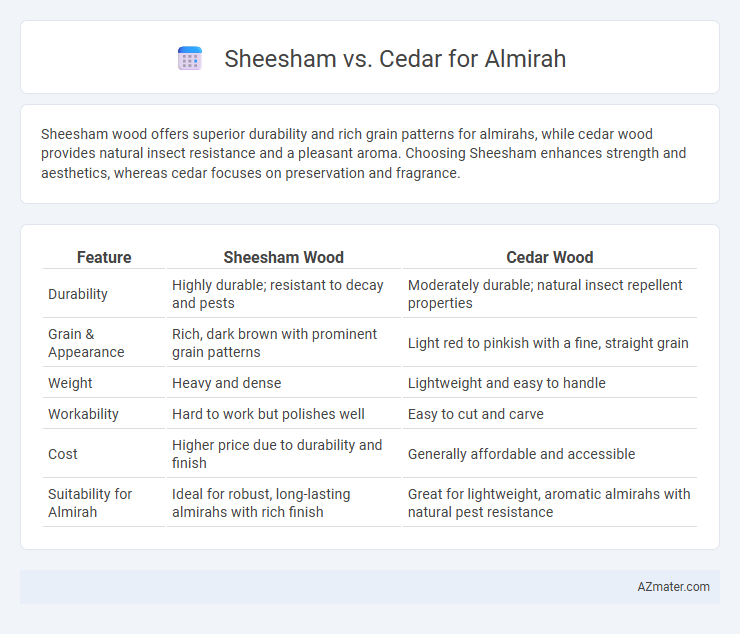Sheesham wood offers superior durability and rich grain patterns for almirahs, while cedar wood provides natural insect resistance and a pleasant aroma. Choosing Sheesham enhances strength and aesthetics, whereas cedar focuses on preservation and fragrance.
Table of Comparison
| Feature | Sheesham Wood | Cedar Wood |
|---|---|---|
| Durability | Highly durable; resistant to decay and pests | Moderately durable; natural insect repellent properties |
| Grain & Appearance | Rich, dark brown with prominent grain patterns | Light red to pinkish with a fine, straight grain |
| Weight | Heavy and dense | Lightweight and easy to handle |
| Workability | Hard to work but polishes well | Easy to cut and carve |
| Cost | Higher price due to durability and finish | Generally affordable and accessible |
| Suitability for Almirah | Ideal for robust, long-lasting almirahs with rich finish | Great for lightweight, aromatic almirahs with natural pest resistance |
Introduction: Sheesham vs Cedar for Almirahs
Sheesham wood, known for its rich grain and durability, offers excellent resistance to pests and moisture, making it a popular choice for almirahs. Cedar wood is valued for its natural aromatic properties and lightweight structure while also providing resistance to termites and decay. Choosing between Sheesham and Cedar for almirahs depends on preferences for sturdiness, appearance, and budget constraints.
Wood Characteristics: Sheesham and Cedar Compared
Sheesham wood, known for its rich grain patterns and high density, offers excellent durability and resistance to termite attacks, making it ideal for sturdy almirahs. Cedar wood features a lighter texture with a natural aromatic scent and inherent resistance to moisture and decay, contributing to long-lasting, mildew-free storage. While Sheesham provides superior hardness and scratch resistance, Cedar excels in lightweight handling and natural insect repellent properties.
Durability and Strength Analysis
Sheesham wood exhibits superior durability and strength compared to cedar, making it an ideal choice for almirahs that require long-lasting structural integrity. Its dense grain and natural oils provide excellent resistance to wear, moisture, and pests, enhancing the lifespan of furniture. Cedar, while lighter and offering natural aromatic properties, is softer and more prone to dents and scratches, reducing its suitability for heavy-use storage units.
Visual Appeal and Aesthetic Differences
Sheesham wood boasts rich, dark grain patterns with natural swirls in brown and golden hues, creating a warm and luxurious visual appeal ideal for almirahs. Cedar offers a lighter, reddish tint with a smooth, uniform texture, providing a classic and elegant aesthetic that brightens interiors. The intricate grain of Sheesham adds depth and rustic charm, while Cedar's subtle patterns lend a clean and refined look to storage furniture.
Resistance to Pests and Decay
Sheesham wood offers superior resistance to pests and decay due to its natural oils and dense grain, making it ideal for durable almirahs in humid climates. Cedar, while naturally resistant to insects and decay thanks to its aromatic oils, tends to be softer and may require regular maintenance to ensure longevity. Both woods provide good pest resistance, but Sheesham's hardness and natural properties generally deliver better long-term durability for almirahs.
Maintenance Requirements for Each Wood
Sheesham wood requires regular polishing with natural oils and gentle cleaning to maintain its rich grain and prevent drying or cracking, benefiting from its dense, oily texture that resists pests and moisture. Cedar wood needs periodic sanding and application of cedar-specific oil to preserve its aromatic quality and natural insect-repellent properties, while also being prone to surface scratches that demand careful handling. Both woods offer durability, but Sheesham's lower maintenance suits high-wear usage compared to Cedar's preference for lighter, aroma-retaining care.
Cost Comparison: Sheesham vs Cedar
Sheesham wood generally offers a more cost-effective option for almirahs compared to cedar, with prices typically ranging from $50 to $150 per cubic foot versus cedar's $80 to $200 per cubic foot. The lower cost of Sheesham is due to its widespread availability and faster growth rate, while cedar's higher price reflects its natural resistance to insects and moisture. Budget-conscious consumers often prefer Sheesham for its affordability and durability without sacrificing aesthetic appeal.
Environmental Impact and Sustainability
Sheesham wood, known for its durability and natural pest resistance, is harvested from the Dalbergia sissoo tree, which is moderately renewable but faces deforestation concerns due to high demand. Cedar wood, typically sourced from the Cedrus species, offers a more sustainable option as it grows faster and often comes from responsibly managed forests with certifications like FSC. Both woods have biodegradable properties, but cedar's natural resistance to decay reduces the need for chemical treatments, making it a greener choice for eco-conscious almirahs.
Popular Uses in Furniture Making
Sheesham, known for its rich grain and durability, is widely favored for crafting almirahs that require sturdy construction and intricate carvings, making it popular in traditional and ornate furniture designs. Cedar, valued for its natural aroma and resistance to insects, is commonly used in almirahs where lightweight and aromatic storage solutions are preferred, especially in regions with high humidity. Both woods serve essential roles in furniture making, with Sheesham's strength and Cedar's aromatic properties influencing their selection for almirahs based on functional and aesthetic priorities.
Which is Better for Almirahs: Final Verdict
Sheesham wood is preferred for almirahs due to its high durability, natural resistance to pests, and rich grain patterns that enhance aesthetic appeal. Cedar wood offers strong aromatic properties and natural insect-repellent qualities, making it suitable for protecting clothes from moths, but it is softer and prone to dents over time. For long-lasting, sturdy, and visually appealing almirahs, Sheesham is generally the better choice, while Cedar suits users prioritizing scent and natural protection.

Infographic: Sheesham vs Cedar for Almirah
 azmater.com
azmater.com